Part of a series of articles titled Alaska Park Science - Volume 19, Issue 1 - Below the Surface: Fish and Our Changing Underwater World.
Article
So Goes the Snow: Alaska Snowpack Changes and Impacts on Pacific Salmon in a Warming Climate
Joel H. Reynolds and Krista K. Bartz, National Park Service
Stephanie A. McAfee, University of Nevada, Reno
Greg Hayward, US Forest Service
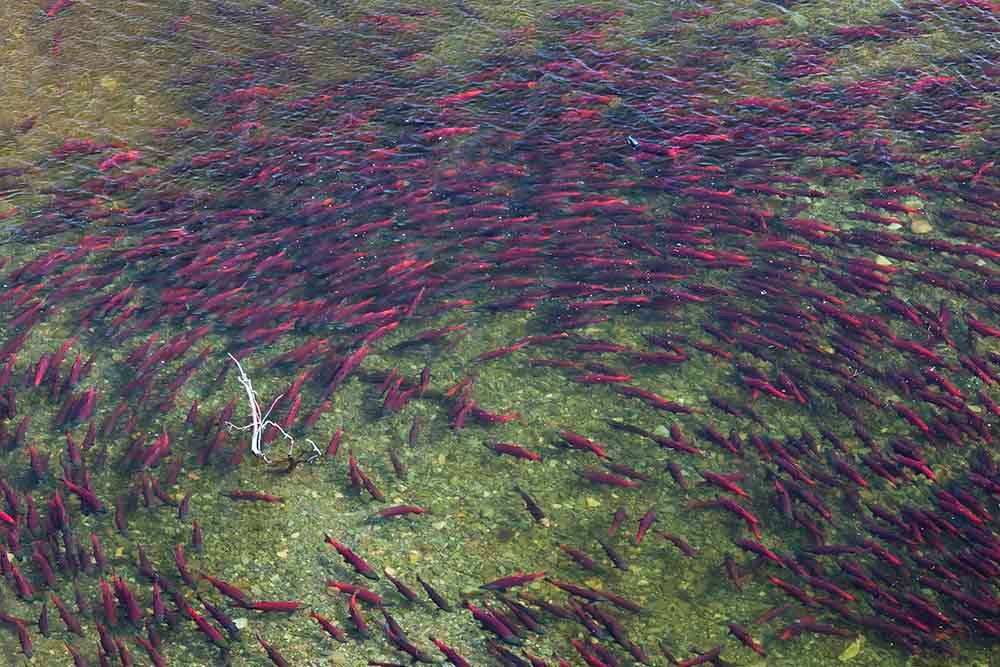
PHOTO COURTESY OF MICHAEL MELFORD
In Alaska’s watersheds, climate change is altering the nature and role of the snowpack, defined as snow accumulation that melts in spring. Generally, the amount of precipitation that falls as snow and the length of the snow-cover season both decrease as temperatures exceed 0°C (32°F) more frequently. The impacts of climate change on snowpack vary among watersheds. In southern, coastal parts of Alaska, large decreases in spring snowpack are expected by the mid-21st century, even with more winter precipitation because temperatures warm to above freezing, causing a shift from snow to rain or more melt during the winter. In contrast, modest early spring increases in the snowpack are expected in watersheds where temperatures remain below freezing. In these locations temperatures warm but remain cold enough for the extra winter precipitation to fall as snow, even though the snowpack will begin accumulating later in the fall and melt earlier in the spring as temperatures rise during those warmer seasons. Because potential impacts on hydrological and ecological systems will vary among watersheds, it is difficult to generalize the resulting ecological impacts at broad spatial scales. Here, we explore likely impacts on hydrology in critical anadromous fish habitat in southwest Alaska.
The Role of Snow in Alaska and its National Parks
In much of Alaska, the landscapes and species we think of as characteristic of place are directly tied to snow. Iconic glaciers define many watersheds and mountain ranges in the state, the result of snow accumulation over centuries, perhaps even millennia. Snow forms a crucial habitat for many familiar species including snowshoe hare (Lepus americanus), wolverine (Gulo gulo), and lynx (Lynx canadensis) whose tracks we see in winter, or redpolls (Carduelis flammea) that can survive cold Arctic nights by burrowing into the snow.
Perhaps less obvious are the many indirect influences of snow on Alaska’s ecosystems (e.g., Cox et al. 2017). The length of the snow-free season determines, in part, which plants dominate tundra environments. (e.g., Wahren et al. 2005). The timing of snowmelt, along with other factors, affects the onset of the fire season in the boreal forest (e.g., Kitzberger et al. 2017). Snow is also crucial for recreation and transportation throughout Alaska. In parts of the state, local hydroelectric power systems and municipal water supplies are dependent on snowpack.
This article focuses on snowpack, or snow that accumulates on the ground, persists through winter, and melts later in the year. The distribution and abundance of the snowpack determines the timing and amount of snowmelt, which affect streamflow, water temperature, and many other attributes of freshwater habitats (e.g., Prowse et al. 2006). These attributes, in turn, influence the growth, movement, reproduction, and survival of Pacific salmon (Oncorhynchus spp.) during the freshwater phases of their lifecycle, which include both juvenile and adult stages (e.g., egg, fry, spawner). For example, lower flow volume can affect outmigration success, or higher water temperature can serve as a migration barrier to incoming spawners.
To address the potential implications for salmon, we first review current understanding of climate change impacts on snow in Alaska and the subsequent expected impacts on streamflow regimes. We then provide a brief overview of potential impacts on salmon resulting from hydrologic changes, focusing on southwest Alaska. We focus on qualitative predictions due to the complexity and challenge of quantitatively predicting the cumulative impacts of the many pathways through which streamflow and water temperature impact salmon distribution and abundance.
How Climate Affects Snow
At first it seems obvious that as climate warms, snowpack should decrease. The Northern Hemisphere’s annual snow cover has very likely decreased due to anthropogenic climate change since at least the 1970s (Najafi et al. 2016). But how such changes unfold depends a lot on which snowpack features are considered (Callahan et al. 2011). For instance, different places in Alaska have very different snow season durations—when snow tends to fall, accumulate, and melt. In the Arctic and the high Alaska Range and Brooks Range, historically (1970-1999) it could snow eight or more months of the year and the snow that fell would likely accumulate much of the year (McAfee et al. 2014, Shulski and Wendler 2007, Stone et al. 2002). But at sea level in coastal southeast Alaska, the reliable snow season was much shorter, as short as one month or less. So as temperature increases, places where much of the snow historically fell within a few degrees of freezing will experience changes in snowfall and snowpack much more quickly than places where temperatures were reliably colder. Snowpack is also affected by the amount and timing of precipitation. The term “snow drought” has been used to describe these two climatic influences on snowpack—lower-than-normal winter precipitation that leads to lower snow accumulation, or warmer-than-normal temperatures that cause precipitation to fall as rain rather than snow or that melt the snow earlier than normal (Harpold et al. 2017). The effects of climate on snowpack also depend on what aspect of snow we measur—for example, how much precipitation falls as snow or rain, whether snow accumulates, whether it melts or is blown away by wind, how much water is entrained in snowpack, and how deep it is.
Here, we use several metrics to describe how snow in Alaska is likely to respond to climate change. The first is snow day fraction, which describes the fraction of wet days in a month where the precipitation falls as snow. Depending on storm characteristics, snow can fall when temperature measured near the earth is above freezing or when it is quite cold, and regional differences in the tendency for snow to fall near freezing or colder conditions affects the snow we actually experience. Estimates of future snow day fraction are based on analysis of the temperature on rainy and snowy days at weather stations across the state. The second is snowfall equivalent, which describes the amount of water in precipitation falling as snow and is driven by both temperature and precipitation amounts. A third is winter precipitation snow index, which describes the amount of precipitation from October to March (the cool season) that remains in the snowpack on April 1st. This is defined as the ratio of April 1st snowfall equivalent to total cool-season precipitation. While April 1st is sometimes earlier than the peak snow accumulation for the year in Alaska, it is the traditional date for snowpack measurement. Finally, we can estimate the months with reliable snow. Here, we assume that if the snow day fraction is above 70%, most of the precipitation arrives as snow and it is cold enough for most of it to accumulate and persist.
Ideally, we would have enough weather stations to measure snow, and the water contained in it, accurately everywhere that matters. But especially in Alaska, long-term weather stations are limited. These four metrics (snow day fraction, snowfall equivalent, winter precipitation snow index, and months with reliable snow) can be derived from regional models of past weather and from global circulation models of future climate, thus allowing us to understand the likely changes in snowpack across regions even where on-the-ground measurements are severely limited.
Climate Change and Snow in Alaska
In the examples that follow, we rely on comparisons between historical conditions (1970-1999, from weather station data and gridded climate data) and future simulated climate from climate models. Technical details underlying these results are described by Littell et al. (2018). We focus on the middle of this century (2040-2069) and use averages of five climate models that work well over Alaska during the historical period. Even without climate change, the amount of snow an area gets, how much of it accumulates, and when it melts varies substantially from year to year and even between decades. Snowpack tracks the high variability in temperature and precipitation, which are in turn driven by ocean temperatures and atmospheric circulation (Shulski and Wendler 2007) that have been shown to affect streamflow in southeast Alaska (Neal et al. 2002). For purposes of vulnerability assessment or adaptation planning, climate change and natural persistent climate variability both contribute to future uncertainty (Hawkins and Sutton 2009).
Climate warming will very likely decrease snow day fraction by decreasing the fraction of total precipitation that falls as snow (McAfee et al. 2014, Lader et al. 2019). Warming will also decrease the duration of the snow season across all of Alaska, by delaying the onset of snow accumulation in autumn and speeding up onset of melt in spring (Littell et al. 2018). These changes will affect places with temperatures commonly near freezing sooner and more drastically than places with temperatures commonly cold enough for snow to accumulate. For example, in southcentral Alaska, from the coast north to Denali National Park and Preserve and west to Lake Clark National Park and Preserve, lower elevations will likely experience decreases of three to five months of reliable snow cover by 2040-2069, or most of the historical reliable snow season (Table 1). In Gates of the Arctic National Park and Preserve and Noatak National Preserve, the reliable snow cover season could change less, decreasing one to two months at lower elevations and less than one month at higher elevations (Figure 1).
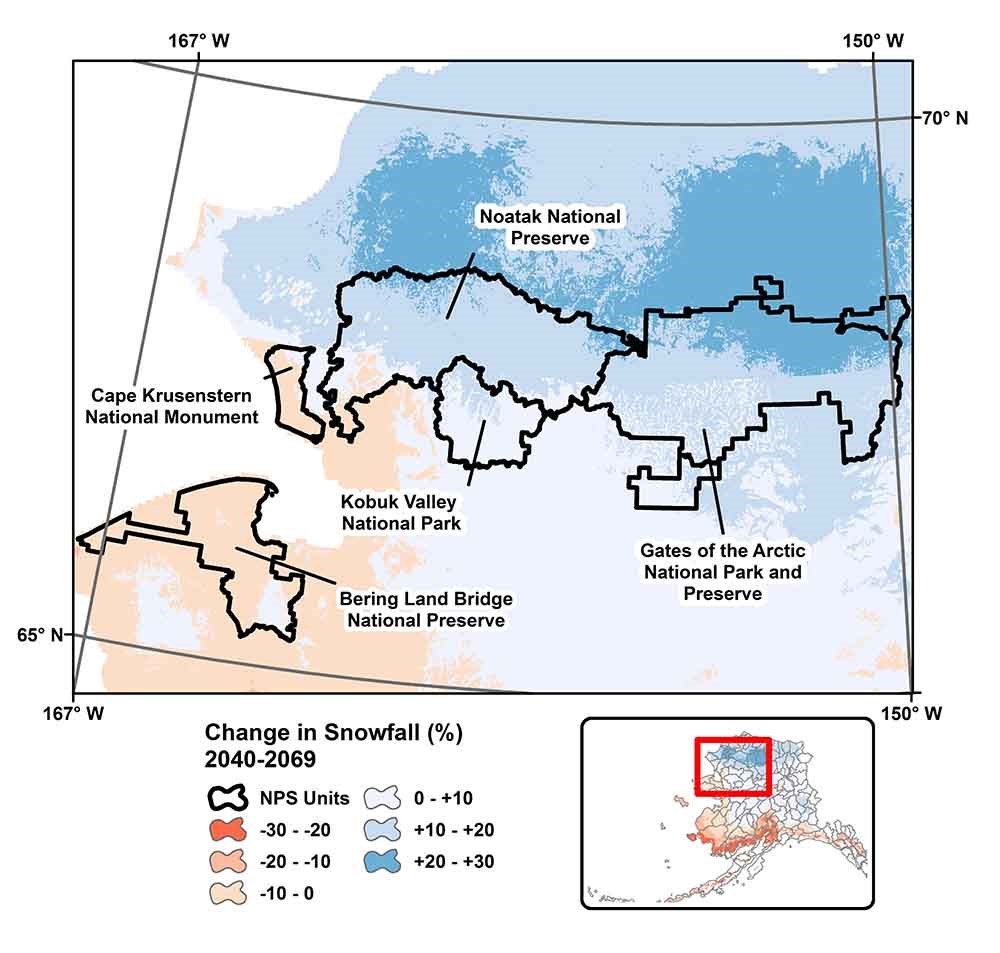
Bering Land Bridge National Preserve experiences the opposite effect, with a decrease in snowfall equivalent over most of its area. The scenario is the average of snowfall projections from five climate models, based on higher emissions scenarios (RCP8.5).
Yet, even as snow day fraction decreases everywhere, the higher elevations (above 4,900 feet or 1,500 m) north of the Alaska Range and much of the North Slope will possibly see snowfall equivalent modestly increase (from 10% to 30%, depending on location). This counterintuitive result is due to the fact that even though temperatures increase, they remain near or below freezing much of the winter, and so the likely increases in precipitation result in more snow. In contrast, the lower and middle elevations (up to about 4,900 feet or 1,500 m) for most of southeast, southcentral, and southwest Alaska, are likely to see snowfall equivalent decrease 20% to 40%, depending on location. Later in the 21st century (2070-2099), many of the northern higher elevation areas eventually may begin to experience decreased snowfall equivalent, though snow in the western Brooks Range is expected to continue to increase. The Arctic parks are a regional example of these projected contrasting trends (Figure 1).
Regional Highlight: Southwest Alaska
Southwest Alaska provides a unique opportunity to learn about climate, snowpack changes, and their effects on ecosystems because of its geographic position at climatic and ecological transitions and its world-renowned wild salmon runs. In this vignette, we examine the changes in snowpack metrics under projected climate and discuss their likely effects on salmon via changes to streamflow in important salmon watersheds of the region. Lake Clark National Park and Preserve, Katmai National Park and Preserve, Aniakchak National Monument and Preserve, and Kenai Fjords National Park—all located in southwest Alaska—include glacier-to-ocean freshwater systems with rivers supporting abundant wild salmon runs.
Climate projections suggest that southwest Alaska will experience some of the largest regional changes in snow day fraction. While some coastal areas historically experienced only brief snow seasons, much of the region supported snow until April or May, with the highest elevations snow-covered until June (Figure 2, upper left panel). By the 2050s, the snow season for much of the region is projected to decrease by one to five months and parts of the region may have no months with persistent snow cover (Figure 2, upper right panel; e.g., most of Katmai National Park and Preserve and all of Alagnak Wild River; for results by park, see Table 1).
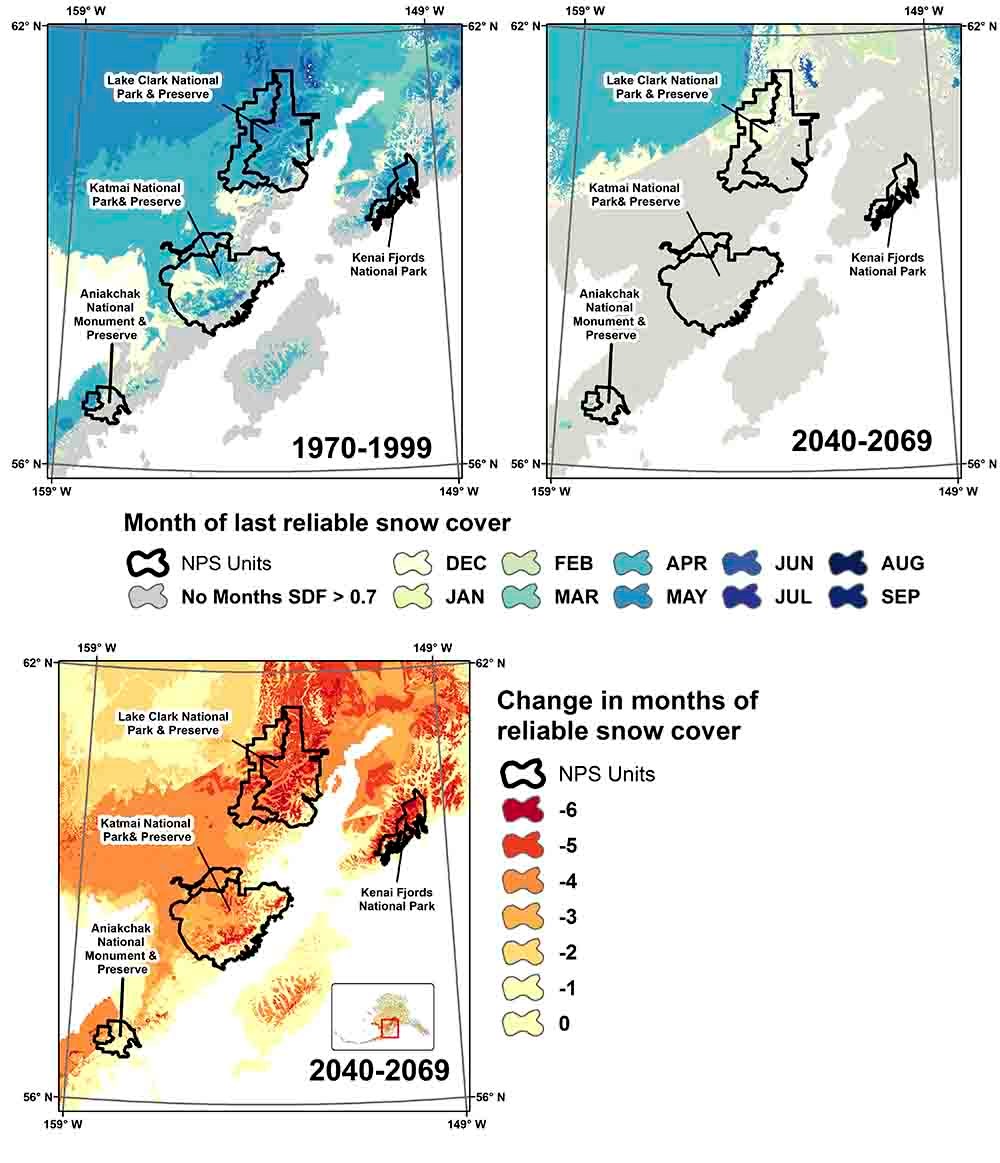
The evident line in the upper right panel is from regionalization of snow day fraction calculations. Along these boundaries, observed responses exhibit characteristics of both regions. Five climate model average, higher emissions (RCP8.5).
The ratio of April 1 snowfall equivalent to total precipitation from October to March (the winter precipitation snow index) gives a good estimate of the amount of water stored in the snowpack and available for runoff during the summer. At values over about 40%, the annual spring melt generates the highest peak in the hydrograph of annual streamflow (see inset); watersheds where at least 40% of the cool-season precipitation falls as snow are considered snow dominant in terms of runoff. Between 40% and about 10%, watersheds are labeled transitional in their seasonal runoff peaks, often with a peak in the spring and early summer driven by snowmelt, a decrease in streamflow during the summer, and a second peak in the autumn with the usual increase in precipitation. If snowfall equivalent is less than 10% of the cool-season precipitation, watersheds are considered rain dominant and the seasonal hydrograph reflects the annual precipitation cycle.
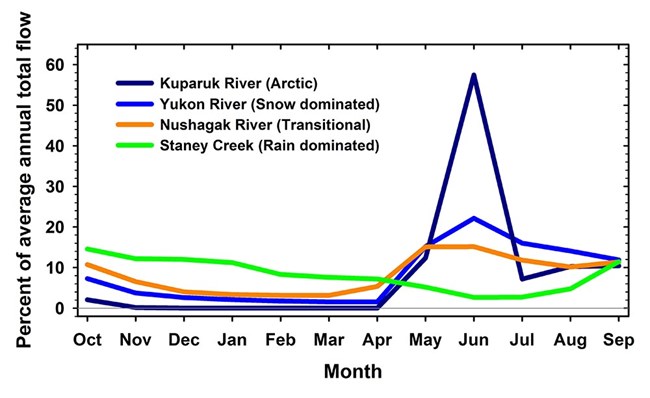
How Different Snowpacks Affect Streamflow
The timing of peak streamflow in watersheds depends on what factors drive the daily, monthly, and seasonal changes in water runoff. In the high Arctic, runoff nearly or entirely ceases for several months during the winter, then increases (often rapidly) with the onset of spring, and stays high as long as snowmelt is available. Runoff may then decrease or stay high if late summer and autumn rains provide runoff before freezing again. On another extreme, in warmer climates with little freezing or snow accumulation, the seasonal cycle of rainfall determines the expected peak streamflow. Calculated over many years of measurement, the average streamflow provides a characteristic seasonal profile, called a hydrograph. Hydrographs (below) illustrate the difference in annual streamflows across a gradient from Arctic snow-dominant (Kuparuk River), to snow-dominant (Yukon River), to transitional (Nushagak River), to rain-dominant (Staney Creek). Each line indicates the mean monthly percentage of annual streamflow for the available years of data. Note the differences in the seasonal peak streamflow and mid-summer responses. While the size of these watersheds varies considerably, the point remains—changes in climate affect snowpack and thus streamflow volume, water availability, and seasonal timing of runoff.
Historically, most southwest Alaska watersheds were considered snow dominant, with a few coastal watersheds experiencing transitional hydrographs. Projected climate conditions (for 2040-2069) push watersheds toward transitional status in all of southwest Alaska. Many lower-elevation watersheds cross the threshold, and a greater fraction of the landscape, especially in Aniakchak and Katmai, become transitional (Figure 3). The detailed hydrologic modelling of future flows that has occurred in a few areas of southwest Alaska (e.g., sections of the upper Nushugak and Kvichak watersheds) suggest that by 2100 at least some streams will have fully shifted to a rain-dominant regime (Wobus et al. 2015).
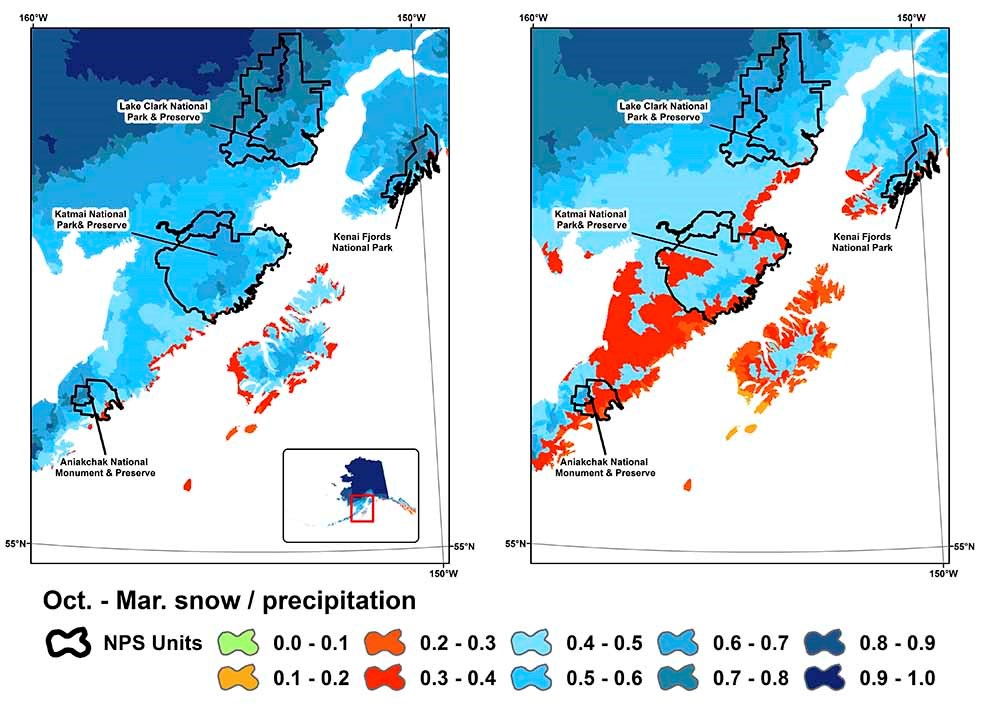
DATA: LITTELL ET AL. 2018.
While changes in snowpack accumulation and snowmelt can be expected to affect streamflow as described above, many of the watersheds in southwest Alaska are also partially influenced by glaciers. Glacier-derived runoff will modify the impacts of changes in snowmelt and snowpack on streamflow and freshwater species, at least temporarily. For example, as climate warms, glaciers initially will contribute increased runoff as they melt. Unlike snowmelt runoff, glacier contributions extend later in the summer and autumn. Consequently, glaciers may offset some changes due to decreasing snowpack early in the runoff season, but also contribute to higher than historical runoff during peak flow in mid and late summer. Therefore the timing of peak flow may shift from that seen in snow-dominant streams. Eventually, the meltwater from receding glaciers will no longer buffer streamflow from the effects of declining snowpack. Meanwhile, salmon and other aquatic organisms will need to adjust to significant changes in streamflow, sediment supply, thermal regimes, and water chemistry as glacier inputs temporarily make up more and more of the streamflow, then decline.
We do not have regional-scale quantitative estimates of how decreasing snowpack or increasing glacier melt will change future streamflows. The watershed configuration and internal processes of glacier response to climate vary greatly, so predicting watershed-level vulnerability to climate change requires more specific modeling. A step towards understanding the combined effects of snowpack and glacier changes is given by a qualitative approach from the Chugach National Forest Climate Change Vulnerability Assessment (Hayward et al. 2017). In a chapter on salmon, Chilcote and others (2017) classified watersheds based on two variables: (1) the winter precipitation snow index (described above), and (2) the current amount of glacier cover in the watershed. Applied to southwest Alaska, this same classification suggests streams will shift toward transitional precipitation status in many watersheds in southeastern Lake Clark and Katmai national parks and preserves (Figure 4). This classification could help prioritize watersheds and stream systems for further study in evaluating impacts of change in snow-driven streamflows on salmon and other ecological resources.

CS = Clear water streams that are snow dominant (<1% glacial)
CT = Clear water streams that are snow transitional (<1% glacial)
TS = Transitional glacial streams that are snow dominant (1-10% glacial)
TT = Transitional glacial streams that are snow transitional (1-10% glacial)
GS = Glacial streams that are snow dominant (>10% glacial)
GT = Glacial streams that are snow transitional (>10% glacial)
Potential Impacts on Salmon
Predicting the impacts of climate change on snowpack, water quantity and quality, and salmon is difficult in southwest Alaska. The available baseline information for weather, climate, streamflow, and salmon is thin compared to the size of the state and the diversity of habitat types therein. Moreover, climate variability is high in this region, with the combined influences from the North Pacific and the Arctic difficult to simulate and predict. For these reasons, we summarize snowpack conditions over 30-year periods rather than describing annual or decadal changes. Likewise, salmon spawning in different streams and lakes within a single watershed, let alone across watersheds, can differ in their genetic, phenotypic, and behavioral traits.
However, we can draw qualitative conclusions regarding likely impacts on salmon due to changes in streamflow and water quality expected to result from changes in snowpack between the historical (1970-1999) and future (2040-2069) periods (Figure 5). First, it is virtually certain that the changes in snowpack will be large enough eventually to shift many streams’ hydrographs from snow dominant to transitional or even rain dominant (Figure 4). In those locations, streamflow would be expected to increase during winter months when salmon eggs are present in the gravel, increasing the possibility of scouring, and consequent egg mortality, during storms (Montgomery et al. 1996). The same changes in snowpack imply that spring peak flow would be expected to decrease (e.g., see Wobus et al. 2015). Changes in the timing and magnitude of streamflow could also lead to changes in the timing of migration for both juveniles moving downstream and adults returning upstream, possibly leading to mismatches between timing and optimal conditions in the modified habitat.
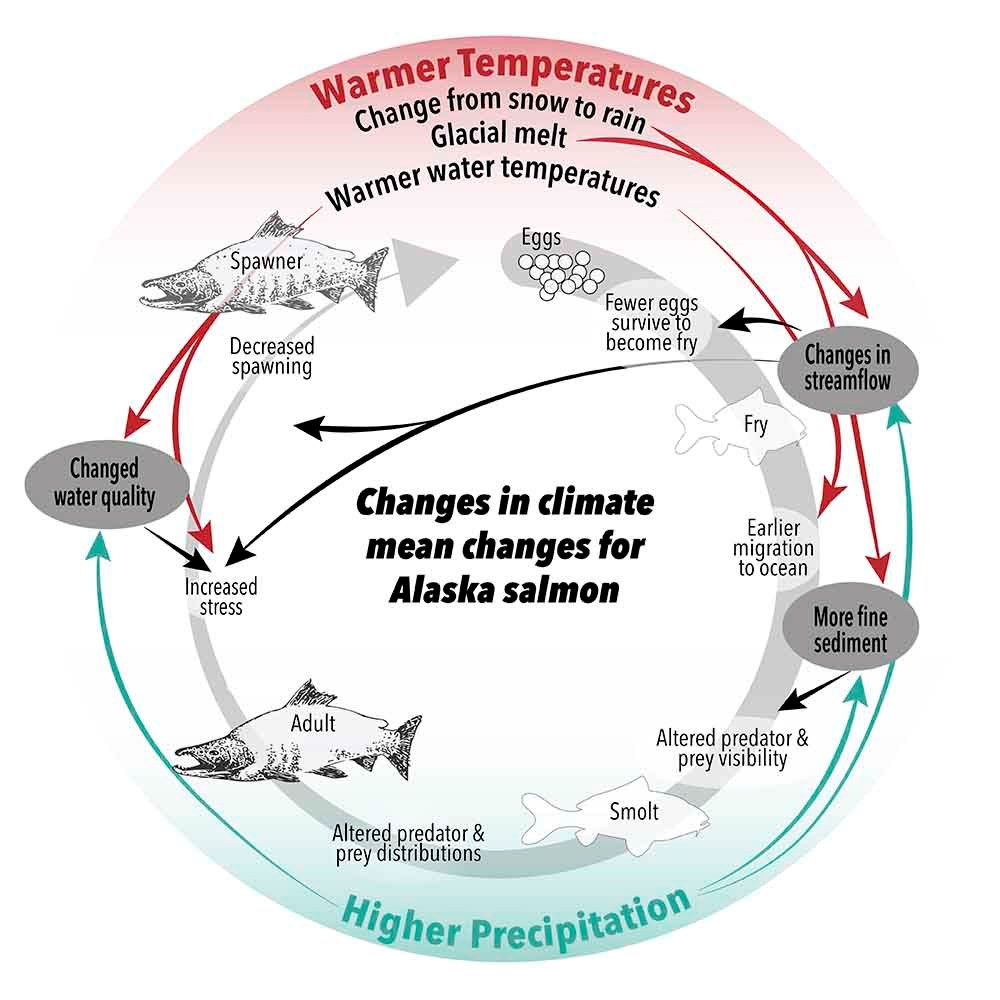
ADAPTED FROM CLIMATE IMPACTS GROUP 2009.
The loss of snowpack influence will remove its buffering effect on maximum stream temperatures, increasing the sensitivity of stream temperature to air temperature (Lisi et al. 2015). During the period of increased rate of glacial melt, fine sediment loads will increase downstream, decreasing survival of eggs to fry (through suffocation or entrapment; Jensen et al. 2009), and limiting the amount of suitable spawning habitat (because suitability depends, in part, on sediment particle size and distribution; Kondolf et al. 2008). Increased fine sediment, when suspended in the water column, could also reduce visibility of prey and predators alike (Gregory and Levings 1998).
Reduced snow cover and winter precipitation as snow, along with increased air temperature, are expected to increase stream water temperature. During winter and spring, warmer waters could hasten development and growth of salmon eggs and fry, possibly leading to earlier life stage transitions (i.e., egg-to-fry and fry-to-smolt; Beacham and Murray 1990). During summer, warmer waters could increase physiological stress on adult salmon migrating to spawning grounds, potentially reducing spawning rates (Sauter et al. 2001). Reduced spawning rates would also result from thermal barriers during migration, such as stretches where water temperatures exceed salmon thermal tolerances (Eliason and Farrell 2016). These are just a few of the expected impacts on specific aspects of salmon lifecycles.
In addition, changes in streamflow, fine sediments, and water temperatures will, ultimately, impact the quantity and quality of accessible salmon habitat, as well as habitat connectivity and complexity. In general, habitat complexity will likely decrease due to declines in glacially influenced systems and losses of snow-dominant hydrographs. This loss of habitat complexity may, eventually, reduce diversity in salmon run timing and thus duration of the period during which returning adult salmon are available for consumption by aquatic, avian, and terrestrial predators (Schindler and Smits 2017).
Lastly, changes in snowpack will simultaneously affect not only salmon but other species in freshwater and marine foodwebs, hinting at the difficulty of trying to account for and synthesize the many potential impacts to any given salmon population. The snowpack and watershed classifications presented here provide a framework for anticipating the most substantial changes in snowpack within Alaska’s national parks. This framework can thus be used as a basis to understand potential responses of salmon to climate-induced changes, which are mediated through cascading changes in salmon habitat conditions.
And So Goes the Snow?
Thriving salmon populations underpin the ecological, economic, and cultural health of southwest Alaska. These salmon populations have gradually adapted, since the last glaciation, to a diversity of habitats. This habitat diversity, and the associated diversity in salmon populations, is called the portfolio effect and is hypothesized to underlie the resilience of these salmon populations in the face of various stressors over the decades (Schindler et al. 2010). However, the rapid rate of the climate change impacts described here far exceeds the historical rates of change that have confronted salmon in the past. The reduction and loss of salmon populations at lower latitudes clearly demonstrates their limited ability to rapidly adapt to human stressors, often termed the “four Hs”: harvest, hydropower, hatcheries, and habitat loss (Ruckelshaus et al. 2002). Alaska, and especially southwest Alaska, strongly benefits from having largely intact freshwater ecosystems and (currently) very limited amounts of other development-related stressors known to negatively impact salmon stocks.
Projected climate change impacts are expected to reduce snowpack and promote glacial melt, reducing salmon habitat quality and diversity. Resource managers tasked with managing and protecting these vulnerable habitats may place greater priority on improving the understanding of stressors affecting salmon habitats to devise solutions for limiting their influence, and thus help sustain the ecological, subsistence, economic and cultural systems that depend on salmon.
Further Information
- National Climate Assessment 4 – Alaska Chapter
- Statistically downscaled projections of snow/rain partitioning for Alaska, McAfee et al. 2014.
- Alaska snowpack response to climate change: Statewide snowfall equivalent and snowpack water scenarios, Littell et al. 2018.
- The portfolio effect regarding the sockeye salmon of southwest Alaska in Biocomplexity and fisheries sustainability, Hilborn et al. 2003.
- Introduction to potential climate change consequences for a portion of Alaska including overviews of glacier, snow, and salmon, Climate Change Vulnerability Assessment for the Chugach National Forest and the Kenai Peninsula.
Any use of trade, firm, or product names is for descriptive purposes only and does not imply endorsement by the US Government.
References
Beacham, T. D. and C. B. Murray. 1990.
Temperature, egg size, and development of embryos and alevins of five species of Pacific salmon: a comparative analysis. Transactions of the American Fisheries Society 119: 927-945.
Callaghan, T.V., M. Johansson, R. D. Brown, P. Y. Groisman, N. Labba, V. Radionov, R. G. Barry, O. N. Bulygina, R. L. H. Essery, D. M. Frolov, V. N. Golubev, T. C. Grenfell, M. N. Petrushina, V. N. Razuvaev, D. A. robinson, P. Romanov, D. Shindell, A. B. Shmakin, S. A. Sokratov, S. Warren, and D. Yang. 2011.
The changing face of Arctic snow cover: A synthesis of observed and projected changes. AMBIO: A Journal of the Human Environment 40: 17-31.
Chilcote, M., A. Coleman, S. Colt, P. Kirchner, G. Reeves, D. Rinella, E. Rothwell, and S. Zemke. 2017.
Chapter 5: Salmon. Pages 107-160 in Hayward et al. Climate Change Vulnerability Assessment for the Chugach National Forest and the Kenai Peninsula. Gen. Tech. Report. PNW-GTR-950. Portland, OR; U.S. Department of Agriculture, Forest Service, Pacific Northwest Research Station. 340 p.
Climate Impacts Group. 2009.
The Washington Climate Change Impacts Assessment, M. McGuire Elsner, J. Littell, and L. Whitely Binder (eds). Center for Science in the Earth System, Joint Institute for the Study of the Atmosphere and Oceans, University of Washington, Seattle, Washington. Available at: http://www.cses.washington.edu/db/pdf/wacciareport681.pdf (accessed April 29, 2020)
Cox, C. J., R. S. Stone, D. C. Douglas, D. M. Stanitski, J. G. Divoky, G. S. Dutton, C. Sweeney, J .C. George, and D. U. Longenecker. 2017.
Drivers and environmental responses to the changing annual snow cycle of Northern Alaska. Bulletin of the American Meteorological Society 98 (12): 2559-2577.
Eliason, E. J. and A.P . Farrell. 2016.
Oxygen uptake in Pacific salmon Oncorhynchus spp.: When ecology and physiology meet. Journal of Fish Biology 88 359-388.
Gregory, R. S. and C. D. Levings. 1998.
Turbidity reduces predation on migrating juvenile Pacific salmon. Transactions of the American Fisheries Society 127:275-285.
Harpold, A., M. Dettinger, and S. Rajagopal. 2017.
Defining snow drought and why it matters. Eos Transactions American Geophysical Union 98.
Hawkins, E. and R. Sutton. 2009.
The potential to narrow uncertainty in regional climate predictions. Bulletin of the American Meteorological Society 90(8):1095-1108.
Hayward, G. H., S. Colt, M. L. McTeague, T. N. Hollingsworth. 2017.
Climate change vulnerability assessment for the Chugach National Forest and the Kenai Peninsula. Gen. Tech. Report. PNW-GTR-950. Portland, OR; U.S. Department of Agriculture, Forest Service, Pacific Northwest Research Station. 340 p.
Hilborn, R., T. P. Quinn, D. E. Schindler, and D. E. Rogers. 2003.
Biocomplexity and fisheries sustainability. Proceedings of the National Academy of Sciences 100: 6564-6568.
Jensen, D. W., E. A. Steel, A. H. Fullerton, and G. R. Pess. 2009.
Impact of fine sediment on egg-to-fry survival of Pacific Salmon: A meta-analysis of published studies. Reviews in Fisheries Science 17: 348-359.
Kitzberger, T., D. A. Falk, A. L. Westerling, and T. W. Swetnam. 2017.
Direct and indirect climate controls predict heterogeneous early-mid 21st century wildfire burned area across western and boreal North America. PLOS ONE 12(12): e0188486.
Kondolf, G. M., J. G. Williams, T. C. Horner, and D. Millan. 2008.
Assessing physical quality of spawning habitat. American Fisheries Society Symposium 65:000-000.
Lader, R., J. E. Walsh, U. S. Bhatt, and P. A. Bieniek. 2020.
Anticipated changes to the snow season in Alaska: Elevation dependency, timing and extremes. International Journal of Climatology 40(1):169-187.
Lisi, P. J., D. E. Schindler, T. J. Cline, M. D. Scheuerell, and P. B. Walsh. 2015.
Watershed geomorphology and snowmelt control stream thermal sensitivity to air temperature. Geophysical Research Letters 42:3380-8.
Littell, J. S., S. A. McAfee, and G. D. Hayward. 2018.
Alaska snowpack response to climate change: Statewide snowfall equivalent and snowpack water scenarios. Water 10(5):668.
McAfee, S. A., J. Walsh, and T. S. Rupp. 2014.
Statistically downscaled projections of snow/rain partitioning for Alaska. Hydrological Processes 28(12):3930-3946.
Montgomery, D. R., J. M. Buffington, N. P. Peterson, D. Schuett-Hames, and T. P. Quinn. 1996.
Streambed scour, egg burial depths, and the influence of salmonid spawning on bed surface mobility and embryo survival. Canadian Journal of Fisheries and Aquatic Sciences 53: 1061-1070.
Najafi, M. R., F. W.Zwiers, and N. P. Gillett. 2016.
Attribution of the spring snow cover extent decline in the Northern Hemisphere, Eurasia and North America to anthropogenic influence. Climatic Change 136: 571-586.
Neal, E. G., M. T. Walter, and M., C. Coffeen. 2002.
Linking the pacific decadal oscillation to seasonal stream discharge patterns in Southeast Alaska. Journal of Hydrology 263(1-4): 188-197.
Prowse, T. D., F. J. Wrona, J. D. Reist, J. J. Gibson, J. E. Hobbie, L. M. Lévesque, and W. F. Vincent. 2006.
Climate change effects on hydroecology of Arctic freshwater ecosystems. AMBIO: A Journal of the Human Environment 35(7):347-359.
Ruckelshaus, M. H., P. Levin, J. B. Johnson, and P. M. Kareiva. 2002.
The Pacific salmon wars: What science brings to the challenge of recovering species. Annual Review of Ecology and Systematics 33:665-706.
Sauter, S. T., J. McMillan, and J. Dunham. 2001.
Issue Paper 1. Salmonid behavior and water temperature. Prepared as part of US EPA Region 10 Temperature Water Quality Criteria Guidance Development Project. EPA-910-D-01-001.
Schindler, D. E., R. Hilborn, B. Chasco, C. P. Boatright, T. P. Quinn, L. A. Rogers, and M. S. Webster. 2010.
Population diversity and the portfolio effect in an exploited species. Nature 465:609-612.
Schindler, D. E. and A. P. Smits. 2017.
Subsidies of aquatic resources in terrestrial ecosystems. Ecosystems 20(1):78-93.
Shulski, M. and G. Wendler. 2007.
The Climate of Alaska. University of Alaska Press, Fairbanks, 216 p.
Stone, R. S., E. G. Dutton, J. M. Harris, and D. Longenecker. 2002.
Earlier spring snowmelt in northern Alaska as an indicator of climate change. Journal of Geophysical Research: Atmospheres 107(D10).
Wahren, C. H., M. D. Walker,and M. S. Bret-Harte. 2005.
Vegetation responses in Alaskan Arctic tundra after eight years of a summer warming and winter snow manipulation experiment. Global Change Biology 11(4):537-552.
Wobus, C., R. Prucha, D. Albert, C. Woll, M. Loinaz, and R. Jones. 2015.
Hydrologic alterations from climate change inform assessment of ecological risk to Pacific salmon in Bristol Bay, Alaska. PLOS ONE 10(12): e0143905.
Last updated: July 23, 2024
